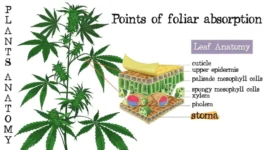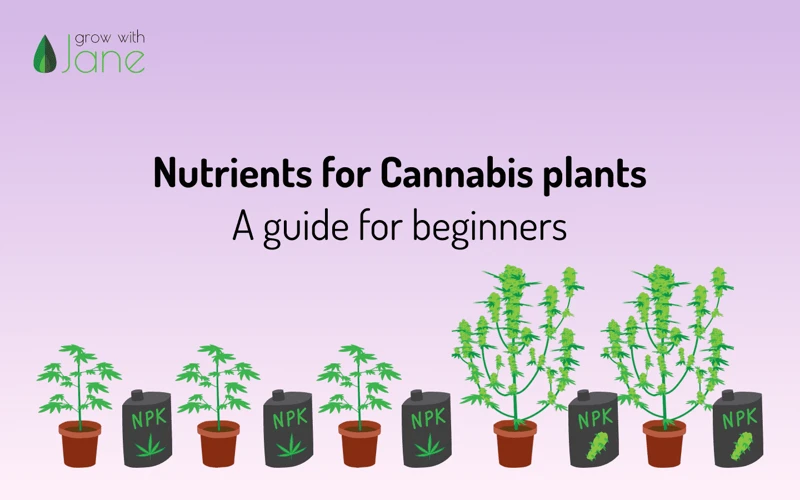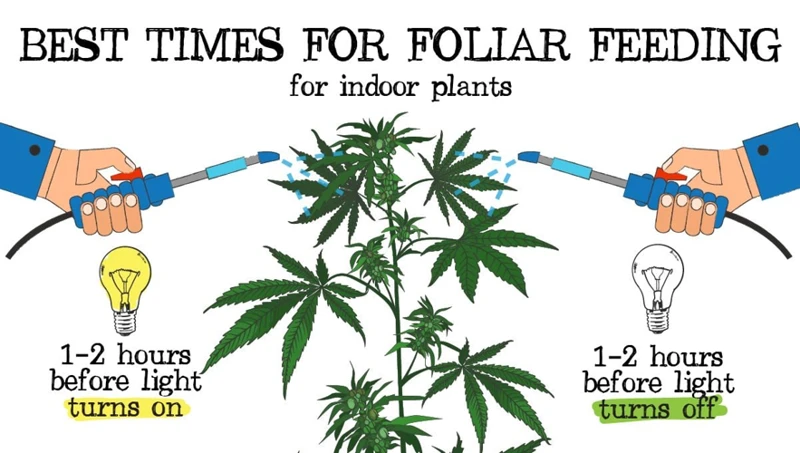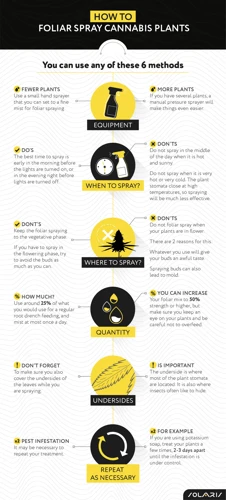
Foliar Feeding vs. Soil Feeding for Cannabis Plants
Introduction
Contents
When it comes to growing cannabis, there are many factors to consider in order to achieve the best possible results. One of the key decisions that growers face is whether to feed their plants through the soil or to apply nutrients directly to the leaves. This may seem like a small choice, but it can have a significant impact on the health and productivity of your plants. In this article, we’ll take a closer look at foliar feeding and soil feeding, identifying the pros and cons of each method and providing guidance on how to determine which approach is best suited to your particular growing situation.
What is Foliar Feeding and Soil Feeding?
Foliar feeding and soil feeding are two common methods of delivering nutrients to your cannabis plants.
Foliar feeding involves spraying a liquid nutrient solution directly on the leaves of your plants. This is done to supplement the nutrients they receive through their roots. The leaves of your plants have small openings called stomata that allow them to absorb nutrients from the surrounding air. By spraying a nutrient solution directly on the leaves, you are able to rapidly deliver nutrients that your plants may be lacking.
Soil feeding, on the other hand, involves adding nutrient-rich solutions directly to your soil or growing medium. This is done to ensure that the roots of your plants have access to a constant supply of nutrients throughout the growth cycle. Soil feeding can be done manually by adding nutrient-rich water to your soil or automatically with the use of a drip system.
Both foliar feeding and soil feeding have their own unique advantages and disadvantages, and the method you choose will depend on a variety of factors including the needs of your cannabis plant and its growth stage. Understanding the differences between these two methods is crucial to ensure that your plants are getting the right nutrients at the right times.
Foliar Feeding
When it comes to feeding your cannabis plants, there are a variety of methods to consider. One popular technique is foliar feeding, which involves applying nutrients directly to the leaves of the plant. This method can be beneficial in some cases, but it also has its drawbacks. Here, we will take a closer look at the pros and cons of foliar feeding and provide a step-by-step guide on how to do it.
Pros
Foliar feeding has several advantages that make it a popular choice for many cannabis growers. Here are some of the benefits of foliar feeding:
- Allows for faster nutrient absorption: Foliar feeding allows nutrients to be absorbed by the plants much faster than soil feeding. This is because the nutrients are applied directly to the leaves, which have a large surface area and are covered in tiny pores called stomata. Stomata help facilitate the exchange of gases and water between the plant and the environment, making nutrient absorption through the leaves much more efficient.
- Targets specific deficiencies: Foliar feeding allows growers to target specific nutrient deficiencies more easily. If a plant is lacking a certain nutrient, it can be added directly to the foliar spray and applied to the affected leaves. This helps to correct the deficiency quickly and efficiently, which can lead to improved plant health and yield.
- Reduces soil nutrient imbalances: Soil can become imbalanced over time if too many nutrients are added or if the soil pH is not properly adjusted. Foliar feeding helps to reduce soil imbalances by providing nutrients directly to the plant and bypassing the soil altogether.
- Reduces the risk of nutrient leaching: Nutrients applied to the soil can easily be lost due to leaching, which occurs when water carrying nutrients moves through the soil and out of the plant’s root zone. Foliar feeding helps to reduce the risk of nutrient leaching by applying nutrients directly to the leaves instead of the soil.
Foliar feeding can be a highly effective way to provide nutrients to cannabis plants, especially during times of nutrient deficiencies or as a supplement to soil feeding. However, there are also some potential downsides to foliar feeding that should be considered before deciding which feeding method to use.
Cons
While foliar feeding can be a useful tool for cannabis growers, it also has its downsides. It’s important to consider these cons before deciding whether to use this method:
| Cons | Explanation |
| Can Damage Leaves | Some foliar sprays can be too strong, causing damage or burning to the leaves. It’s important to dilute the spray and test it on a small section of the plant before applying it more broadly. |
| Less Efficient | When nutrients are applied to the leaves, they don’t have the same direct access to the plant’s root system. This can make foliar feeding less efficient than soil feeding in terms of nutrient uptake. |
| Increased Risk of Pests | Moisture on the leaves from foliar feeding can attract pests, which can damage or kill the plant. It’s important to keep a close eye on the plant after foliar feeding to make sure no pests are present. |
While these cons are significant, with proper care and attention, they can be mitigated. It’s important to weigh them against the potential benefits and make an informed decision for your cannabis grow.
How to Foliar Feed
Foliar feeding is the technique of spraying a nutrient-rich solution directly onto the leaves of your cannabis plant, in order to provide them with the necessary minerals and nutrients needed for optimal growth and development. Here is a step-by-step guide on how to successfully foliar feed your cannabis plants:
Step 1: Choose the right time to foliar feed. It’s best to foliar feed during the early morning or late afternoon, as the sun won’t be too harsh on your plants during these times.
Step 2: Mix your nutrient solution in a spray bottle. Be sure to follow the manufacturer’s instructions and mix the solution to the recommended strength.
Step 3: Adjust the pH of your solution to between 5.5 and 6.5, as cannabis plants prefer acidic solutions.
Step 4: Test a small area of your plant with your solution to check for any negative reactions. Wait 24 hours and observe your plant for any signs of damage or stress.
Step 5: Begin spraying your plant with the nutrient solution. Be sure to aim for the undersides of the leaves as this is where the majority of nutrient uptake occurs.
Step 6: Spray your plant until the solution begins to run off. Ensure that every leaf is evenly coated.
Step 7: Repeat the process every 2-3 days, taking care not to over-feed your plant. If you notice any signs of stress or damage, discontinue foliar feeding and evaluate your feeding schedule.
By following these steps, you can successfully foliar feed your cannabis plants and provide them with the nutrients they need for healthy growth and development.
Soil Feeding
As a cannabis grower, you may be wondering which feeding method is right for your plants. While foliar feeding may have its benefits, soil feeding is also a tried and true method that has been used for generations. By delivering nutrients directly to the soil, your cannabis plants are able to absorb them through their roots and develop a strong and healthy root system. In this section, we will explore the pros and cons of soil feeding and provide you with step-by-step instructions on how to effectively deliver nutrients to your cannabis plants through the soil.
Pros
Foliar feeding has several advantages over soil feeding. Some of these advantages include:
| Advantage | Description |
|---|---|
| Speed of Nutrient Delivery | Foliar feeding allows nutrients to be quickly absorbed through the leaves of the plant and delivered directly to the target areas, which can result in faster growth and improved overall health of the plant. |
| Ability to Target Specific Issues | When using foliar feeding, it is possible to adjust the formulation to target specific nutrient deficiencies or issues that are affecting the plant, such as mold or pests. |
| Reduced Risk of Nutrient Lockout | Since nutrients are delivered directly to the leaves of the plant, the risk of nutrient lockout is reduced. Soil feeding can lead to nutrient buildup and pH imbalances that can block the absorption of other nutrients. |
| Reduced Water Usage | In soil feeding, nutrients are delivered through water, which can lead to a lot of waste due to run-off. With foliar feeding, you can directly target the leaves and use less water overall. |
It should be noted that while foliar feeding has its benefits, it is not a replacement for soil feeding entirely. It is important to find a balance between both methods to ensure optimal growth and health of your cannabis plants.
Cons
One important aspect to consider when deciding whether to use foliar feeding or soil feeding for your cannabis plants is the potential disadvantages of each method. Let’s take a look at the cons of each option:
| Foliar Feeding Cons | Soil Feeding Cons |
|---|---|
| Can burn leaves if not properly diluted or applied | Can lead to nutrient lockout if nutrients are not properly balanced |
| Can promote the growth of pathogens and pests | Slow-release nutrients may not be available to the plant as quickly as with foliar feeding |
| May not provide enough nutrients for plants with high nutrient demands | Difficult to correct nutrient deficiencies once they develop |
As we can see, each method has its own set of cons that growers need to consider. With foliar feeding, there is the risk of burning leaves if the nutrients are not properly diluted or applied. Additionally, the application of nutrients through foliage can promote the growth of pathogens and pests. On the other hand, soil feeding can lead to nutrient lockout if nutrients are not properly balanced, which can be difficult to correct once it occurs. Slow-release nutrients may also not be available to the plant as quickly as with foliar feeding. Finally, soil feeding may not provide enough nutrients for plants with high nutrient demands and correcting nutrient deficiencies can be difficult.
How to Soil Feed
Soil feeding is the oldest and most traditional way of feeding plants. This method involves adding nutrients directly to the soil or growing medium in which the cannabis plants are grown. Here is a step-by-step guide on how to soil feed your cannabis plants:
Step 1: Choose the Right Nutrients
Before you begin soil feeding, you need to make sure that you have the right nutrients for your cannabis plants. There are many options available on the market, and each one has different nutrient ratios depending on the stage of growth your plants are in.
Step 2: Calculate the Correct Amount
Once you have selected your nutrients, you need to calculate the correct amount to add to your soil or growing medium. Excessive nutrient application can harm your plants, so it is crucial to follow the recommended dosage on the label and to avoid overfeeding.
Step 3: Mix the Nutrients into the Soil
Mix the nutrients into the soil or the growing medium carefully. For best results, mix thoroughly and evenly to make sure that the nutrients are evenly distributed throughout the soil.
Step 4: Water Your Plants
After adding the nutrients to the soil, you will need to water your cannabis plants to ensure that the nutrients are absorbed. Make sure to use the right amount of water because excessive watering can leach out the nutrients from the soil.
Step 5: Monitor Your Plants
As your plants grow, it is essential to monitor them closely for any signs of nutrient deficiency or excess. Make sure to adjust your feeding regimen accordingly based on your observation.
Step 6: Flush the Soil Regularly
Over time, salts and nutrient build-up can accumulate in the soil or growing medium, leading to nutrient lockouts or plant toxicity. Therefore you need to flush the soil with plain water every few weeks to remove the accumulated salts and nutrients.
By following these straightforward steps, you can effectively soil feed your cannabis plants and promote their growth in a healthier and more natural way.
Which Method is Right for You?
Choosing between foliar feeding and soil feeding can be a daunting decision for cannabis growers. It’s crucial to understand the pros and cons of each method to determine which one is suitable for your cannabis plant. Additionally, several factors such as the plant’s needs and growth stage influence the decision. Let’s take a look at the essential considerations when picking between foliar and soil feeding.
Cannabis Plant Needs
Cannabis plants have specific nutrient requirements that need to be met to maintain healthy growth and to maximize yield. Understanding the nutrient needs of cannabis plants is crucial to choosing the right feeding method.
Macronutrients: Cannabis plants need three primary macronutrients: nitrogen (N), phosphorus (P), and potassium (K). Nitrogen is needed for vegetative growth, phosphorus assists with root and flower development, and potassium plays a critical role in overall plant health and stress resistance.
Micronutrients: In addition to macronutrients, cannabis plants also require various micronutrients such as calcium, magnesium, sulfur, and iron, just to name a few. While these micronutrients are often present in soil, they still need to be replenished periodically.
Water: Cannabis plants need proper hydration to grow effectively. Water is essential in the process of photosynthesis, which is how plants produce energy.
pH Balance: Cannabis plants need to be grown in soil with a balanced pH. The optimal pH range for soil-grown cannabis is between 6.0 and 7.0. Outside of this range, cannabis plants can have difficulty taking in nutrients.
Light: Proper lighting is crucial to the growth of cannabis plants. They require light to carry out photosynthesis, which is crucial for growth and production.
To choose the right feeding method, it is essential to take into account the specific nutrient needs of your cannabis plant. By providing your cannabis plants with the proper nutrients, you can help them thrive and achieve the highest yield possible.
Growth Stage
The growth stage of your cannabis plants is another important factor to consider when deciding between foliar feeding and soil feeding. At different stages of growth, the plants have different nutrient requirements, and both methods have their advantages and disadvantages.
Seedling Stage: During this stage, cannabis plants are very delicate and need to be handled with care. Foliar feeding can be beneficial here as it allows the plants to absorb nutrients quickly, which can help them establish a healthy root system. However, it’s important to be cautious with foliar feeding as the plants are delicate and may not be able to handle excess nutrients. Soil feeding can also be done during this stage, but it’s important to use a gentle, nutrient-rich soil that won’t overwhelm the young plants.
Vegging Stage: This is the stage where your cannabis plants will experience the most growth, and their nutrient requirements will be higher. Soil feeding can be beneficial here as it allows the plants to absorb nutrients over a longer period of time. However, foliar feeding can also be useful for providing a quick boost of nutrients to the plants.
Flowering Stage: During this stage, cannabis plants will require less nitrogen and more phosphorus and potassium. Soil feeding is generally preferred during this stage as it provides a steady release of nutrients. However, if you’re experiencing nutrient deficiencies or want to give your plants a quick boost of nutrients, foliar feeding can also be done.
Both foliar feeding and soil feeding can be beneficial at different stages of growth, and the method you choose will depend on your specific needs and the needs of your plants. It’s important to monitor your plants and adjust your feeding methods as needed to ensure they are getting the proper nutrients for healthy growth.
Conclusion
In conclusion, the decision to use foliar feeding or soil feeding for your cannabis grow ultimately depends on a variety of factors, such as the plant’s specific needs and growth stage. It’s essential to understand the pros and cons of each method and how to properly execute them.
Remember that foliar feeding has the potential to provide quick nutrient uptake and can be useful for addressing specific deficiencies. However, it can also be risky and should be used sparingly to avoid potential harm to your plants.
On the other hand, soil feeding provides slow but steady nutrient uptake and is typically less risky than foliar feeding. It’s essential to amend your soil correctly to ensure that the necessary nutrients are available to your plant.
It’s crucial to prioritize proper plant care and regularly monitor your plants to ensure that they are receiving the necessary nutrients to thrive. Whichever feeding method you choose, it’s essential to follow proper dosing guidelines and avoid overfeeding your plants.
Ultimately, the success of your cannabis grow depends on the careful consideration of various factors and the implementation of proper feeding techniques. By taking the time to understand the needs of your plants and following best practices, you can cultivate a healthy and productive cannabis garden.
Frequently Asked Questions
What nutrients are commonly applied through foliar feeding?
Common nutrients applied through foliar feeding include nitrogen, potassium, phosphorus, iron, and calcium.
How often should I foliar feed my cannabis plants?
It is recommended to foliar feed your cannabis plants once a week, preferably in the morning or evening when temperatures are lower.
Can I foliar feed my cannabis plants during the flowering stage?
Yes, you can foliar feed your cannabis plants during the flowering stage, but it’s recommended to use a fertilizer with a low nitrogen content to avoid the risk of nutrient burn.
What are some common soil amendments for cannabis plants?
Common soil amendments for cannabis plants include bat guano, bone meal, worm castings, crab meal, blood meal, and fish emulsion.
How often should I water my cannabis plants when using soil feeding?
It is recommended to water your cannabis plants with soil feeding once or twice a week, depending on the size of your plants and environmental conditions.
Can I use hydroponic nutrients for soil feeding?
Yes, you can use hydroponic nutrients for soil feeding, but make sure to dilute them properly and follow the recommended feeding schedule for the specific nutrient brand.
What are some signs of overfeeding my cannabis plants with soil feeding?
Signs of overfeeding your cannabis plants with soil feeding include burnt or yellowing tips, weak or slow growth, nutrient burn, and wilting leaves.
What are some signs of underfeeding my cannabis plants with foliar feeding?
Signs of underfeeding your cannabis plants with foliar feeding include yellowing or stunted growth, and nutrient deficiencies.
Can I combine foliar feeding and soil feeding for my cannabis plants?
Yes, you can combine foliar feeding and soil feeding for your cannabis plants, but make sure to follow the recommended feeding schedule and avoid overfeeding.
Which feeding method is better for maximizing cannabis yields?
Both foliar feeding and soil feeding can be used effectively to maximize cannabis yields, but it ultimately depends on your specific growing environment and the needs of your plants. Experiment with both methods and determine which works best for your situation.





